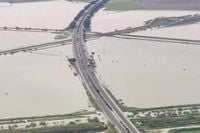As heavy rainfall continues to affect Spain, the recent storm, dubbed Martinho, has led to massive disruptions across various regions. On March 22, the Dirección General de Tráfico (DGT) reported that 22 main roads in Andalusia and Comunidad Valenciana had been closed due to flooding and sinkholes, a situation exacerbated by the potential for snow which has made travel hazardous across many areas.
As officials worked to manage the chaos, they issued stern warnings highlighting the danger of aquaplaning and reduced grip on wet roads. DGT shared vital driving tips for navigating the treacherous conditions. These include checking road conditions before traveling, avoiding standing water, driving smoothly, and if visibility is poor, simply stopping the vehicle in a safe location. Proper vehicle maintenance, such as ensuring wipers were functional and keeping lights on, was also emphasized.
According to reports, as of March 22 at 14:00, snow had impacted 17 roads in central and northern Spain, while continued rainfall raised alerts across several provinces. Specifically, provinces including Segovia, Ávila, Madrid, and León had been flagged for snowfall, with warnings extending into the Pyrenees the next day. Traffic continues to be affected not only by closure of these roads but also due to flooding incidents. An accident on the A-2 in San Fernando de Henares complicated traffic out of Madrid, adding to the congestion from another incident on the A-5 toward Talavera de la Reina.
In Cádiz, six secondary roads remained closed as of March 22 due to the relentless rains. The DGT reported that the AP-4 had reopened but required caution near kilometer 38. Meanwhile, other routes like CA-3101 Añina and CA-3102 Jerez de la Frontera faced similar closures. Authorities in the region worked to address flooded areas even as they kept a close eye on the weather forecast.
Despite temporary improvements as flood waters recede in some spots, the situation still poses risks. The heavy rains have led to severe incidents throughout Spain, resulting in casualties and significant infrastructure damage. As of March 22, authorities confirmed that three individuals had tragically lost their lives in the flooding in Andalusia, and search efforts were ongoing for a missing motorcyclist who was believed to have been swept away.
In response to the extreme weather, the Emergency Services of Madrid issued guidelines including avoiding unnecessary travel and opting for public transportation where possible. Furthermore, local businesses and educational institutions kept a close watch on the situation, with many suspending classes or activities as a precautionary measure.
The current situation marks one of the most intense rainfall episodes in decades, raising serious concerns over already saturated soils and swollen rivers. The mayor of Ávila has declared a state of emergency in light of what he called “one of the worst flooding crises the city has seen in a century.” The overflowing rivers Adaja and Chico have flooded homes, businesses, and public spaces, necessitating immediate emergency measures.
A special alert was issued for the Tajo River, which is currently at risk of flooding in several municipalities. In areas such as Talavera de la Reina, the river surged to alarming levels that prompted local officials to recommend that citizens stay away from potentially hazardous areas.
The DGT has continued to inform and update the public through various media channels, underlining the importance of being mindful of road and weather conditions. Their updated warnings draw attention to the special attention needed for secondary roads, which remain vulnerable to flash floods and other weather-related disruptions.
On a broader scale, this storm is just the latest in a series of extreme weather events impacting Spain. Meteorologists predict a colder than average spring with ongoing rainfall expected well into the season. Citizens are urged to remain vigilant and prioritize their safety above all else.
The long-term implications of these events will need to be assessed once the weather stabilizes, but for now, the priority remains clear: ensuring public safety and maintaining access to critical infrastructure. With ongoing surveillance and emergency response efforts, local and national authorities are doing their utmost to manage this crisis effectively.







